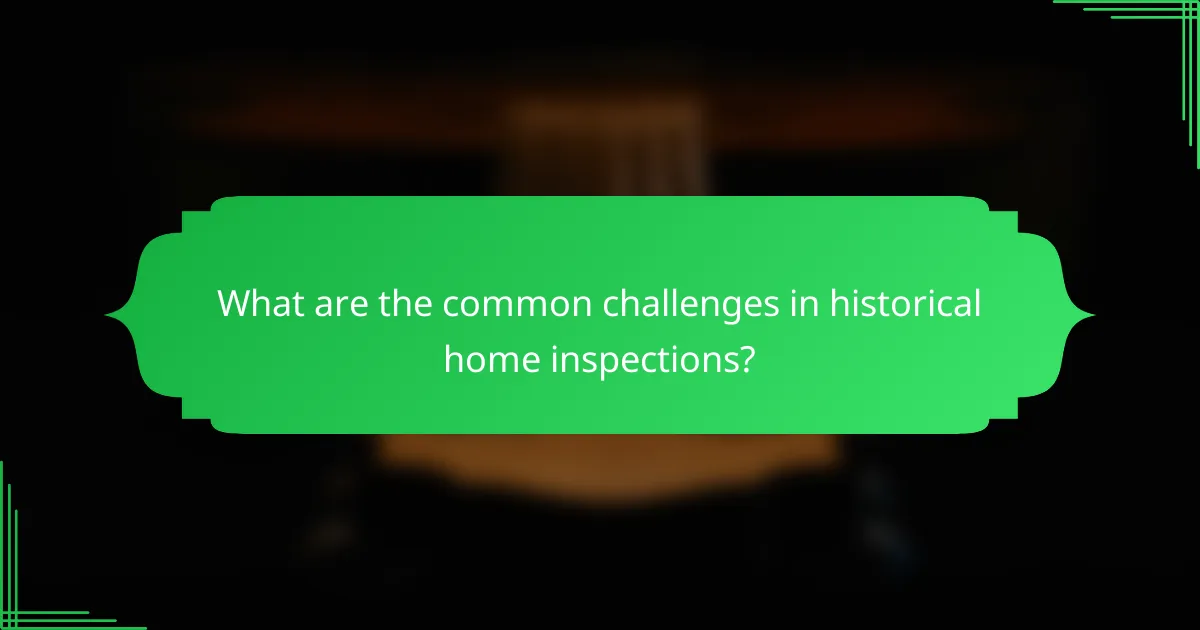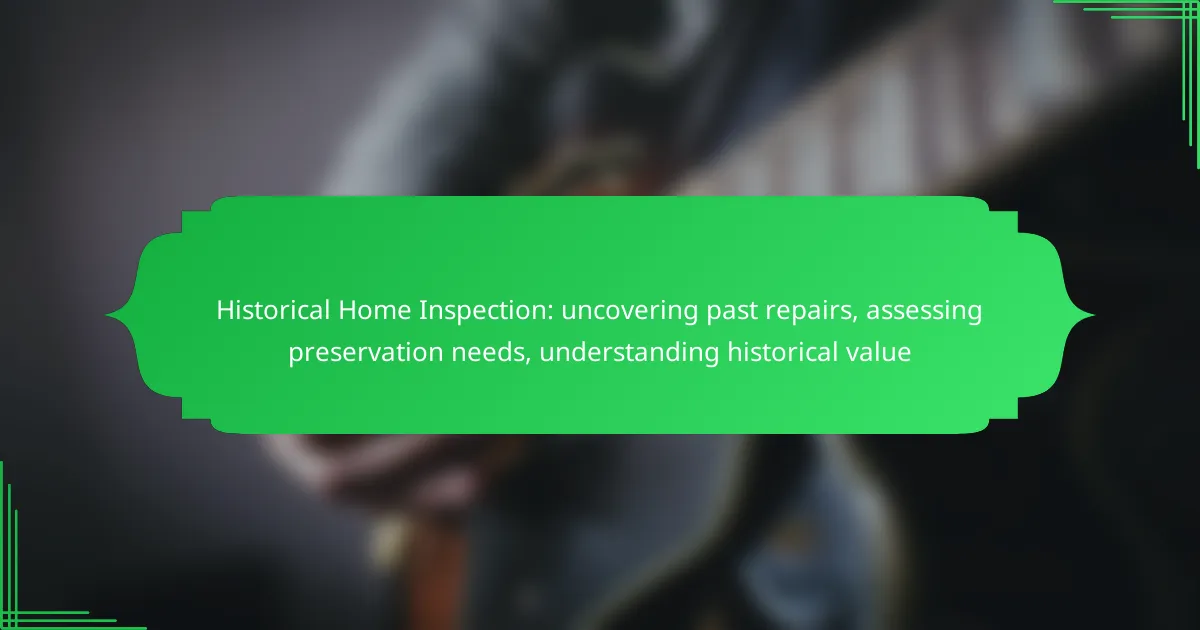Historical home inspection is a critical process that uncovers past repairs and assesses the preservation needs of a property. By examining the structural integrity, original materials, and compliance with preservation laws, inspectors can determine the overall historical value and significance of the home. This thorough evaluation not only guides preservation efforts but also informs potential buyers about the property’s worth within its historical context.

How to uncover past repairs in historical homes?
Uncovering past repairs in historical homes involves examining various sources and features to assess their condition and historical significance. This process helps determine what preservation needs exist and the overall historical value of the property.
Review of historical records
Start by accessing historical records, such as property deeds, renovation permits, and tax assessments. These documents can provide insights into previous repairs, ownership changes, and any alterations made over the years.
Local archives, historical societies, or municipal offices often house these records. Look for any documentation that details significant repairs or restorations, as this can highlight the home’s maintenance history and inform future preservation efforts.
Inspection of architectural features
Conduct a thorough inspection of the home’s architectural features, focusing on materials, craftsmanship, and design elements typical of its era. Pay attention to any signs of wear, damage, or modifications that may indicate past repairs.
Common features to examine include windows, doors, moldings, and roofing. Identifying original materials versus replacements can help assess the home’s authenticity and guide restoration decisions.
Consultation with previous owners
Engage with previous owners or long-term residents to gather firsthand accounts of the home’s history. They may provide valuable information about repairs, renovations, and maintenance practices that are not documented elsewhere.
Consider conducting informal interviews or surveys to capture their experiences. This personal insight can enrich your understanding of the home’s past and inform your preservation strategy.

What preservation needs should be assessed?
Assessing preservation needs involves evaluating the structural integrity, original materials, and compliance with local preservation laws of a historical home. This ensures that the property maintains its historical value while meeting safety and regulatory standards.
Structural integrity evaluation
Structural integrity evaluation focuses on identifying any weaknesses in the building’s framework. Inspectors should look for signs of settling, cracks in walls, or issues with the foundation that may compromise safety. Regular assessments can help catch problems early, preventing costly repairs later.
Common indicators of structural issues include uneven floors, doors that stick, and visible gaps in window frames. If any of these signs are present, a professional structural engineer should be consulted to conduct a thorough analysis.
Assessment of original materials
Assessing original materials is crucial for maintaining the historical authenticity of a home. This involves identifying and evaluating the condition of materials such as wood, brick, and plaster that were used in the original construction. Preserving these materials can enhance the property’s historical value.
When assessing original materials, consider factors like age, wear, and compatibility with modern repair techniques. For example, using traditional lime mortar instead of modern cement can help maintain the integrity of historic masonry.
Compliance with local preservation laws
Compliance with local preservation laws ensures that any renovations or repairs adhere to regulations designed to protect historical properties. Each locality may have specific guidelines regarding alterations, restorations, and even maintenance practices that must be followed.
Homeowners should familiarize themselves with local preservation ordinances and may need to obtain permits before starting any work. Engaging with local preservation societies can provide valuable resources and support in navigating these regulations.

How to determine the historical value of a property?
Determining the historical value of a property involves assessing its significance, condition, and context within its historical period. This evaluation can guide preservation efforts and inform potential buyers about its worth.
Appraisal by certified historical valuators
Engaging certified historical valuators is essential for an accurate appraisal of a property’s historical value. These professionals specialize in assessing properties based on their architectural style, historical context, and condition, ensuring that the evaluation aligns with established standards.
When selecting a valuator, look for credentials from recognized organizations, such as the American Society of Appraisers or similar bodies in your country. Their expertise can help identify unique features that contribute to a property’s historical significance.
Comparison with similar historical properties
Comparing a property with similar historical properties can provide valuable insights into its value. Look for properties of the same era, style, and location to establish a baseline for comparison.
Consider factors such as size, condition, and any renovations made. For example, if a comparable property recently sold for a specific amount, it can serve as a reference point for your property’s valuation. Local real estate listings or historical societies can be good resources for finding comparable properties.
Analysis of historical significance
Analyzing the historical significance of a property involves examining its role in local history, architecture, or culture. This can include its association with notable events or figures, as well as its representation of specific architectural styles.
Research local archives, historical societies, or online databases to gather information about the property’s past. Understanding its significance can enhance its value and inform preservation strategies, ensuring that any renovations respect its historical integrity.

What are the common challenges in historical home inspections?
Historical home inspections often face unique challenges that can complicate the assessment process. Inspectors must navigate hidden damages, outdated building codes, and non-compliant renovations that may not meet current standards.
Identifying hidden damages
Hidden damages in historical homes can include structural issues, water damage, or pest infestations that are not immediately visible. Inspectors should look for signs such as discoloration on walls, warped floors, or unusual odors that may indicate underlying problems.
Using tools like moisture meters and thermal imaging cameras can help uncover these hidden issues. It’s advisable to conduct a thorough examination of the attic, basement, and crawl spaces, as these areas often reveal critical information about the home’s condition.
Understanding outdated building codes
Many historical homes were built under different building codes that may no longer be applicable today. Inspectors must familiarize themselves with the original codes and how they differ from current regulations to assess compliance accurately.
In some cases, modifications may need to be made to bring the home up to code, which can be costly. Homeowners should consult local building authorities to understand the specific requirements for their area, as these can vary significantly.
Dealing with non-compliant renovations
Non-compliant renovations are common in historical homes, as previous owners may have made changes without adhering to modern standards. Inspectors should evaluate these renovations to determine if they pose safety risks or affect the home’s historical integrity.
It’s essential to document any non-compliant work and discuss potential remedies with the homeowner. In some cases, restoring the home to its original condition may be necessary, while in others, modifications can be made to ensure safety without compromising historical value.

What criteria should be used for selecting a historical home inspector?
Selecting a historical home inspector requires careful consideration of their experience, knowledge of preservation standards, and client references. These criteria ensure that the inspector can accurately assess the unique needs of historical properties and provide valuable insights into their preservation.
Experience with historical properties
When choosing a historical home inspector, prioritize those with substantial experience specifically in historical properties. Inspectors who have worked on similar homes are more likely to recognize unique architectural features and potential issues that may not be present in modern constructions.
Look for inspectors who can provide examples of past projects, detailing the types of historical homes they have inspected. A seasoned inspector should be familiar with various architectural styles and the common repairs or renovations associated with them.
Knowledge of preservation standards
An effective historical home inspector should have a solid understanding of local and national preservation standards. This knowledge is crucial for assessing whether any modifications made to the property comply with regulations that protect its historical integrity.
Inspectors should be aware of guidelines set by organizations such as the National Park Service or local preservation societies. Familiarity with these standards helps ensure that any recommendations made during the inspection align with best practices for maintaining historical value.
References from previous clients
Requesting references from previous clients is an essential step in the selection process. Positive feedback from past clients can provide insights into the inspector’s reliability, thoroughness, and professionalism.
Consider asking for references specifically related to historical home inspections. This will help gauge the inspector’s ability to address the unique challenges associated with older properties and their effectiveness in communicating findings to clients.

What are the benefits of historical home inspections?
Historical home inspections provide valuable insights into a property’s past repairs, preservation needs, and overall historical significance. These inspections help homeowners and buyers understand the condition of the home, ensuring that its historical value is maintained while addressing any necessary renovations.
Uncovering past repairs
Uncovering past repairs is a crucial aspect of historical home inspections. Inspectors examine records, documents, and physical evidence to identify previous work done on the property. This information can reveal how well the home has been maintained and whether any repairs were completed to historical standards.
For instance, if a home has undergone significant renovations, understanding the quality and methods used can inform future restoration efforts. Homeowners should look for signs of structural changes, material replacements, and any alterations that may affect the home’s historical integrity.
Assessing preservation needs
Assessing preservation needs involves evaluating the current condition of the home and determining what repairs or maintenance are necessary to protect its historical features. This includes checking for issues like water damage, pest infestations, and deterioration of original materials.
Homeowners should prioritize maintaining original elements such as windows, doors, and moldings. Regular maintenance can prevent costly repairs down the line and ensure that the home remains true to its historical character. Consulting with preservation specialists can provide additional guidance on best practices.
Understanding historical value
Understanding historical value is essential for homeowners who wish to preserve their property’s legacy. This involves recognizing the architectural style, historical significance, and cultural context of the home. Such knowledge can enhance the property’s appeal and market value.
Homeowners should research the history of their home and its previous occupants, as this can provide a richer narrative that adds to its value. Engaging with local historical societies or preservation organizations can also offer resources and support for maintaining the home’s historical integrity.
